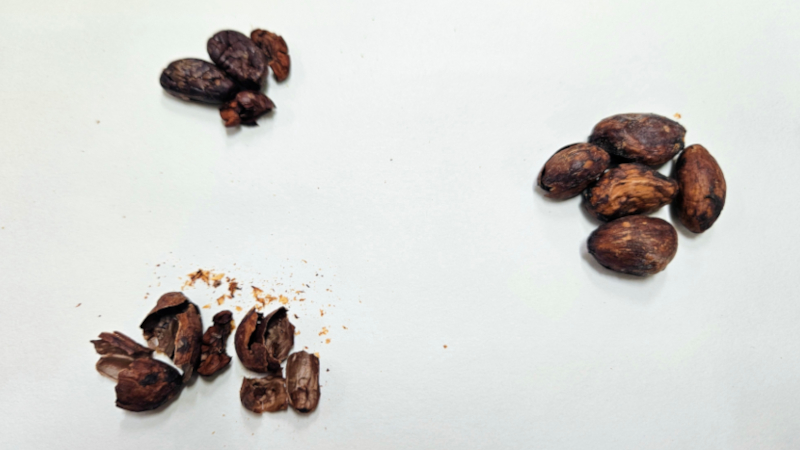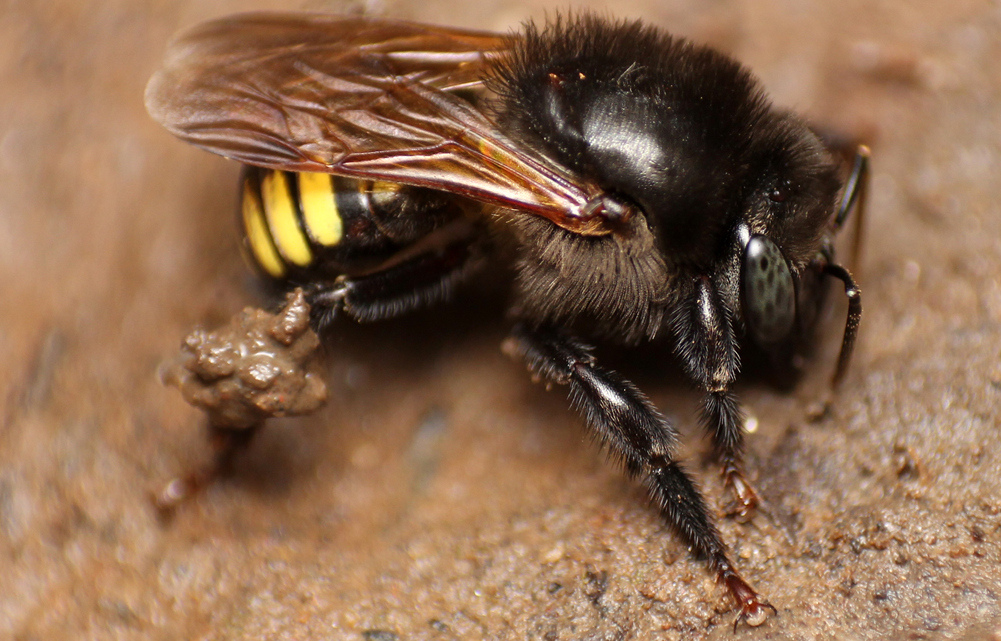

Cocoa bean shells contain theobromine and caffeine, which can be transferred to honey from stingless bees using ultrasound-assisted extraction (photo: Felipe Bragagnolo/FCA-UNICAMP)
Researchers at the State University of Campinas used a product from native stingless bees to extract bioactive compounds, such as caffeine, from chocolate manufacturing waste. This process adds nutritional and commercial value to an ingredient that is usually discarded.
Researchers at the State University of Campinas used a product from native stingless bees to extract bioactive compounds, such as caffeine, from chocolate manufacturing waste. This process adds nutritional and commercial value to an ingredient that is usually discarded.

Cocoa bean shells contain theobromine and caffeine, which can be transferred to honey from stingless bees using ultrasound-assisted extraction (photo: Felipe Bragagnolo/FCA-UNICAMP)
By André Julião | Agência FAPESP – A group of researchers from the State University of Campinas (UNICAMP) in the state of São Paulo, Brazil, developed a product made from native bee honey and cocoa bean shells that can be consumed directly or used as an ingredient in food and cosmetics. The results were published in the journal ACS Sustainable Chemistry & Engineering, which featured the study on its cover.
The researchers used native bee honey as an edible solvent to extract stimulants such as theobromine and caffeine, which are associated with heart health, from cocoa bean shells. These shells are usually discarded during the production of chocolate and other cocoa derivatives. The ultrasound-assisted extraction process also enriched the honey with phenolic compounds, which have antioxidant and anti-inflammatory properties.
The researchers who tasted it say that, depending on the ratio of honey to shells, it has a strong chocolate flavor, although they are still planning tests on the product’s taste and other sensory properties.
“Of course, the biggest appeal to the public is the flavor, but our analyses have shown that it has a number of bioactive compounds that make it quite interesting from a nutritional and cosmetic point of view,” says Felipe Sanchez Bragagnolo, the first author of the study, which he conducted during his postdoctoral research at the Faculty of Applied Sciences (FCA) at UNICAMP in Limeira with a scholarship from FAPESP.
In partnership with INOVA UNICAMP, the university’s innovation agency, the authors are looking for a partner interested in licensing the patented process and bringing the product to market (read more at agencia.fapesp.br/52969).
Biodiversity
In addition to promoting the sustainable use of local biodiversity, honey from native bees was chosen for its greater potential as a solvent because it generally has higher water content and lower viscosity than honey from European bees (Apis mellifera).
Honey from five species found in Brazil was tested: borá (Tetragona clavipes), jataí (Tetragonisca angustula), mandaçaia (Melipona quadrifasciata), mandaguari (Scaptotrigona postica), and moça-branca (Frieseomelitta varia). The cocoa shells were provided by the São Paulo State Department of Agriculture and Supply’s Comprehensive Technical Assistance Coordination Office (CATI) unit in São José do Rio Preto.

One of the honeys tested came from the mandaçaia bee (Melipona quadrifasciata) (photo: Lucas Rubio/iNaturalist)
Mandaguari honey was initially chosen for process optimization due to its intermediate water and viscosity values. However, the optimized process was later used for the other honeys analyzed.
Bragagnolo points out that honey is highly susceptible to external influences, such as climate, storage conditions, and temperature. “Therefore, it’s possible to adapt the process to locally available honey, not necessarily mandaguari honey,” he says.
Green chemistry
Ultrasound-assisted extraction involves placing a probe, visually similar to a metal pen, inside a pot containing honey and shells. The probe uses sound waves to enhance the extraction of compounds from the shells, which then migrate to the solvent – in this case, honey.
This method is efficient because it creates microbubbles that implode and temporarily increase the temperature to break down the plant material. This technique is considered environmentally friendly in the food industry because it is faster and more efficient than other methods.
This was one of the positive points in another assessment included in the study, which measured the product’s sustainability. The Path2Green software was used. It was developed by a group led by Professor Mauricio Ariel Rostagno from FCA-UNICAMP, who is also Bragagnolo’s postdoctoral supervisor and coordinator of the study.
The tool verified compliance with 12 principles of green chemistry, such as transportation, post-treatment, purification, and application. Using an edible, local, ready-to-use solvent was one of the most important factors. On a scale of -1 to +1, the product scored +0.118.
“We believe that with a device like this, in a cooperative or small business that already works with both cocoa and native bee honey, it’d be possible to increase the portfolio with a value-added product, including for haute cuisine,” Rostagno suggests.
The researchers are preparing new studies to evaluate the effect of ultrasound on honey microbiology. As with plant material, the method breaks down the cell walls of microorganisms, such as bacteria, that can degrade the product.
“Honey from native bees usually needs to be refrigerated, matured, dehumidified, or pasteurized, unlike honey from European bees, which can be stored at room temperature. We suspect that, simply by being exposed to ultrasound, the microorganisms contained in the honey are eliminated, increasing the stability and shelf life of the product,” he explains.
In the future, they will test other applications using honey from native bees as a solvent for ultrasound-assisted extraction, such as processing other plant residues.
In addition to fellowships for postdoctoral research and an internship abroad for Bragagnolo, the work received a series of scholarships and grants from FAPESP (23/02064-8, 23/16744-0, 21/12264-9, 20/08421-9, 19/13496-0, and 18/14582-5.
The article “Stingless bee honeys as natural and edible extraction solvents: an intensified approach to cocoa bean shell valorization” can be read at pubs.acs.org/doi/10.1021/acssuschemeng.5c04842.
Republish
The Agency FAPESP licenses news via Creative Commons (CC-BY-NC-ND) so that they can be republished free of charge and in a simple way by other digital or printed vehicles. Agência FAPESP must be credited as the source of the content being republished and the name of the reporter (if any) must be attributed. Using the HMTL button below allows compliance with these rules, detailed in Digital Republishing Policy FAPESP.





